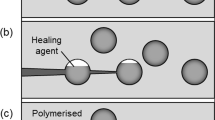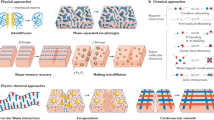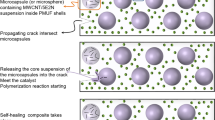Abstract
Nanoparticles have useful properties, but it is often important that they only start working after they are placed in a desired location. The encapsulation of nanoparticles allows their function to be preserved until they are released at a specific time or location, and this has been exploited in the development of self-healing materials1,2,3,4,5,6,7,8,9,10 and in applications such as drug delivery11. Encapsulation has also been used to stabilize and control the release of substances, including flavours, fragrances and pesticides12,13,14. We recently proposed a new technique for the repair of surfaces called ‘repair-and-go’15,16. In this approach, a flexible microcapsule filled with a solution of nanoparticles rolls across a surface that has been damaged, stopping to repair any defects it encounters by releasing nanoparticles into them, then moving on to the next defect. Here, we experimentally demonstrate the repair-and-go approach using droplets of oil that are stabilized with a polymer surfactant and contain CdSe nanoparticles. We show that these microcapsules can find the cracks on a surface and selectively deliver the nanoparticle contents into the crack, before moving on to find the next crack. Although the microcapsules are too large to enter the cracks, their flexible walls allow them to probe and adhere temporarily to the interior of the cracks. The release of nanoparticles is made possible by the thin microcapsule wall (comparable to the diameter of the nanoparticles) and by the favourable (hydrophobic–hydrophobic) interactions between the nanoparticle and the cracked surface.
This is a preview of subscription content, access via your institution
Access options
Subscribe to this journal
Receive 12 print issues and online access
$259.00 per year
only $21.58 per issue
Buy this article
- Purchase on Springer Link
- Instant access to full article PDF
Prices may be subject to local taxes which are calculated during checkout




Similar content being viewed by others
References
Blaiszik, B. J. et al. Self-healing polymers and composites. Ann. Rev. Mater. Res. 40, 179–211 (2010).
White, S. R. et al. Autonomic healing of polymer composites. Nature 409, 794–797 (2001).
Blaiszik, B. J. et al. Microcapsules filled with reactive solutions for self-healing materials. Polymer 50, 990–997 (2009).
Caruso, M. M. et al. Robust, double-walled microcapsules for self-healing polymeric materials. ACS Appl. Mater. Interfaces 2, 1195–1199 (2010).
White, S. R., Caruso, M. M. & Moore, J. S. Autonomic healing of polymers. MRS Bull. 33, 766–769 (2008).
Balazs, A. C., Emrick, T. & Russell, T. P. Nanoparticle polymer composites: where two small worlds meet. Science 314, 1107–1110 (2006).
Gupta, S., Zhang, Q. L., Emrick, T., Balazs, A. C. & Russell, T. P. Entropy-driven segregation of nanoparticles to cracks in multilayered composite polymer structures. Nature Mater. 5, 229–233 (2006).
Murphy, E. B. & Wudl, F. The world of smart healable materials. Prog. Polym. Sci. 35, 223–251 (2010).
Toohey, K. S., Sottos, N. R., Lewis, J. A., Moore, J. S. & White, S. R. Self-healing materials with microvascular networks. Nature Mater. 6, 581–585 (2007).
Wu, D. Y., Meure, S. & Solomon, D. Self-healing polymeric materials: a review of recent developments. Prog. Polym. Sci. 33, 479–522 (2008).
Duncan, R. The dawning era of polymer therapeutics. Nature Rev. Drug Discov. 2, 347–360 (2003).
Madene, A., Jacquot, M., Scher, J. & Desobry, S. Flavour encapsulation and controlled release—a review. Int. J. Food Sci. Technol. 41, 1–21 (2006).
Ji, Q. et al. Stimuli-free auto-modulated material release from mesoporous nanocompartment films. J. Am. Chem. Soc. 130, 2376–2377 (2008).
Kulkarni, A. R., Soppimath, K. S., Aminabhavi, T. M., Dave, A. M. & Mehta, M. H. Glutaraldehyde crosslinked sodium alginate beads containing liquid pesticide for soil application. J. Control. Rel. 63, 97–105 (2000).
Kolmakov, G. V. et al. Using nanoparticle-filled microcapsules for site-specific healing of damaged substrates: creating a ‘repair-and-go’ system. ACS Nano 4, 1115–1123 (2010).
Verberg, R., Dale, A. R., Kumar, P., Alexeev, A. & Balazs, A. C. Healing substrates with mobile, particle-filled microcapsules: designing a ‘repair and go’ system. J. R. Soc. Interface 4, 349–357 (2007).
Barrick, B., Campbell, E. J. & Owen, C. A. Leukocyte proteinases in wound healing: roles in physiologic and pathologic processes. Wound Repair Regen. 7, 410–422 (1999).
Kratz, K., Breitenkamp, K., Hule, R., Pochan, D. & Emrick, T. PC-polyolefins: synthesis and assembly behavior in water. Macromolecules 42, 3227–3229 (2009).
Boker, A., He, J., Emrick, T. & Russell, T. P. Self-assembly of nanoparticles at interfaces. Soft Matter 3, 1231–1248 (2007).
Lin, Y. et al. Nanoparticle assembly at fluid interfaces: structure and dynamics. Langmuir 21, 191–194 (2005).
Lin, Y., Skaff, H., Emrick, T., Dinsmore, A. D. & Russell, T. P. Nanoparticle assembly and transport at liquid–liquid interfaces. Science 299, 226–229 (2003).
Acknowledgements
The authors acknowledge support from the National Science Foundation (NSF), through the NSF Materials Research Science and Engineering Center (MRSEC) on Polymers at UMass Amherst (DMR-0820506), an IGERT award (DGE-0504485, to K.K.), NSF-CBET-0932781 and the NSF-NSEC Center for Hierarchical Manufacturing (DMI-0531171). A.B. acknowledges support from the Department of Energy (grant no. DE-FG02-90ER45438) and T.P.R. from the Department of Energy Office of Basic Energy Science (grant no. DE-FG02-04ER46126).
Author information
Authors and Affiliations
Contributions
A.B., A.J.C., T.E. and T.P.R. conceived the idea and experimental implementation. R.R., R.T., S.K. and S.M. designed and performed the initial experiments. A.B. and G.K. outlined the theoretical basis for the work. A.N., H.S.K. and K.K. prepared the materials and performed the experiments. A.B., A.J.C., K.K., T.E. and T.P.R. were responsible for drafting and editing the manuscript.
Corresponding author
Ethics declarations
Competing interests
The authors declare no competing financial interests.
Supplementary information
Supplementary information
Supplementary information (PDF 716 kb)
Rights and permissions
About this article
Cite this article
Kratz, K., Narasimhan, A., Tangirala, R. et al. Probing and repairing damaged surfaces with nanoparticle-containing microcapsules. Nature Nanotech 7, 87–90 (2012). https://doi.org/10.1038/nnano.2011.235
Received:
Accepted:
Published:
Issue Date:
DOI: https://doi.org/10.1038/nnano.2011.235
This article is cited by
-
Solventless preparation of ammonium persulfate microcapsules with a polypyrrole shell
Journal of Materials Science (2019)
-
Enhanced dual-responsive shape memory nanocomposites with rapid and efficient self-healing capability
Journal of Materials Science (2018)
-
Computational approaches to substrate-based cell motility
npj Computational Materials (2016)
-
The role of mechanics in biological and bio-inspired systems
Nature Communications (2015)



